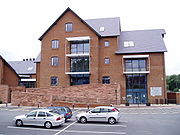
Frankwell
Encyclopedia

Shrewsbury
Shrewsbury is the county town of Shropshire, in the West Midlands region of England. Lying on the River Severn, it is a civil parish home to some 70,000 inhabitants, and is the primary settlement and headquarters of Shropshire Council...
, in Shropshire
Shropshire
Shropshire is a county in the West Midlands region of England. For Eurostat purposes, the county is a NUTS 3 region and is one of four counties or unitary districts that comprise the "Shropshire and Staffordshire" NUTS 2 region. It borders Wales to the west...
, England
England
England is a country that is part of the United Kingdom. It shares land borders with Scotland to the north and Wales to the west; the Irish Sea is to the north west, the Celtic Sea to the south west, with the North Sea to the east and the English Channel to the south separating it from continental...
. It lies adjacent to the River Severn
River Severn
The River Severn is the longest river in Great Britain, at about , but the second longest on the British Isles, behind the River Shannon. It rises at an altitude of on Plynlimon, Ceredigion near Llanidloes, Powys, in the Cambrian Mountains of mid Wales...
, to the northwest of the town centre, and is one of Shrewsbury's oldest suburbs.
Frankwell grew up as a port and trading location by the river and on the road to Wales
Wales
Wales is a country that is part of the United Kingdom and the island of Great Britain, bordered by England to its east and the Atlantic Ocean and Irish Sea to its west. It has a population of three million, and a total area of 20,779 km²...
, but across the river from the walled borough of Shrewsbury and therefore beyond the town's jurisdiction. There have been a number of suggestions about where the name derives from, but one possible origin is "Frankville", which means a town of free trade. Being independent from the larger borough of Shrewsbury gave it a local nickname of the Little Borough, a name which is used to this day.
Today Frankwell continues to be a commercial area of the town, lying just outside the town centre, with its own character and identity. There has been much redevelopment recently near to the river, especially now flood defences have been constructed, and new buildings include Shrewsbury Town Council's Guildhall and Theatre Severn.
Early origins
Frankwell's origins are connected with the crossing of the River Severn from the meander core which forms the centre of Shrewsbury. Water Lane, which still exists today, led to a ford over the river that was probably a crossing point in the early Middle Ages. St George's BridgeSt George's Bridge
St George's Bridge was a bridge over the River Severn in Shrewsbury, England; so named as it was close to St. George's Hospital. It connected Frankwell, an old suburb of the town, to the town centre via Mardol. The gate on the town side was called Mardol Gate and is located where the Mardol Quay...
, a fortified and partly inhabited structure, was built in the mid twelfth century. This bridge, which also became known as Welsh(man's) Bridge in the thirteenth century, crossed the river from the end of Mardol on the town side to a position close to the former Methodist chapel on the Frankwell side. Although this bridge was demolished in the 1790s, remnants of the foundations and land arches remain.
A number of buildings in Frankwell show evidence of Frankwell's medieval development. 92 Frankwell is the surviving half of a two-bay cruck-framed hall house, and 111-12 Frankwell are a pair of early fifteenth century semi-detached houses. Boundaries in the oldest part of Frankwell have been strongly influenced by medieval burgage plots approached from the main street through passages.
Early modern period
Frankwell was highly prosperous in the sixteenth to eighteenth centuries. 4-7 Frankwell is an imposing building with ground-floor shops and first- and second- floor workshops above, built in about 1590. 113-14 Frankwell, built around 1620, remains a splendid and imposing half-timbered building. Late seventeenth and early eighteenth century buildings, including the 'Anchor' public house, line the corner to the approach to the old Welsh Bridge.The old Welsh Bridge (St George's Bridge) was replaced by the present day Welsh Bridge in the 1790s. The new Welsh Bridge is located some 70m (80 yards) further downstream from the old bridge.
Frankwell today

Frankwell Forge was a small industrial area by the side of the Welsh Bridge, founded in 1878 and closed only recently, in 2004. It closed to make way for the new theatre complex planned for the area. The name of the company which operated the site when it closed was "H and E Davies".
Also in Frankwell is St George's Church and Frankwell Quay (with its small marina/boat yard and the town's only major permanent flood defences). Two bridges connect the district with the town centre - the historic Welsh Bridge and the modern Frankwell Footbridge. Flooding, which affected the district regularly and badly, no longer occurs due to flood defences built in 2002/03. Only the main car park and some houses on New Street are affected by flooding today.
Frankwell gained notoriety for the 2006 'Brothel Slayings' in which 2 women were brutally murdered with a blunt instrument. The brothel
Brothel
Brothels are business establishments where patrons can engage in sexual activities with prostitutes. Brothels are known under a variety of names, including bordello, cathouse, knocking shop, whorehouse, strumpet house, sporting house, house of ill repute, house of prostitution, and bawdy house...
, now closed, was situated next to the Wheatsheaf pub and is now a musical instrument shop.

